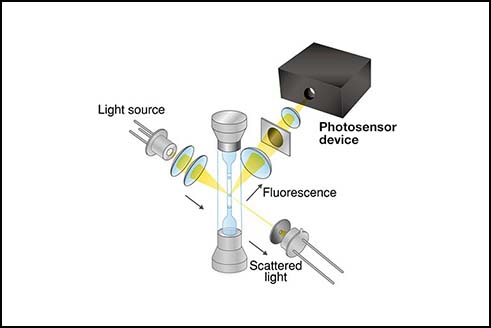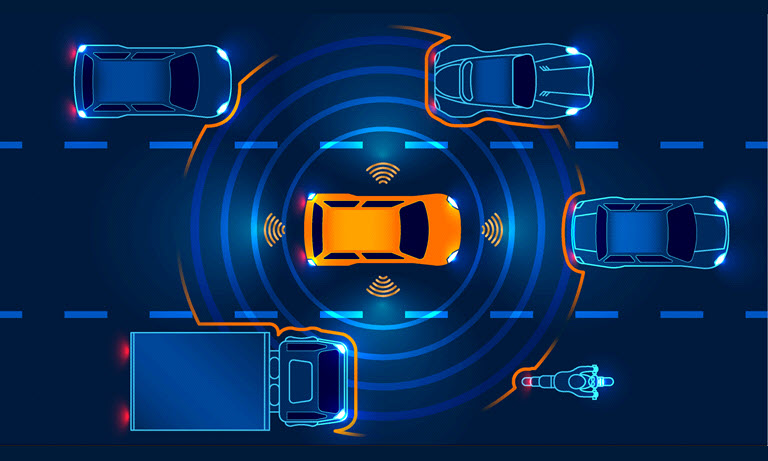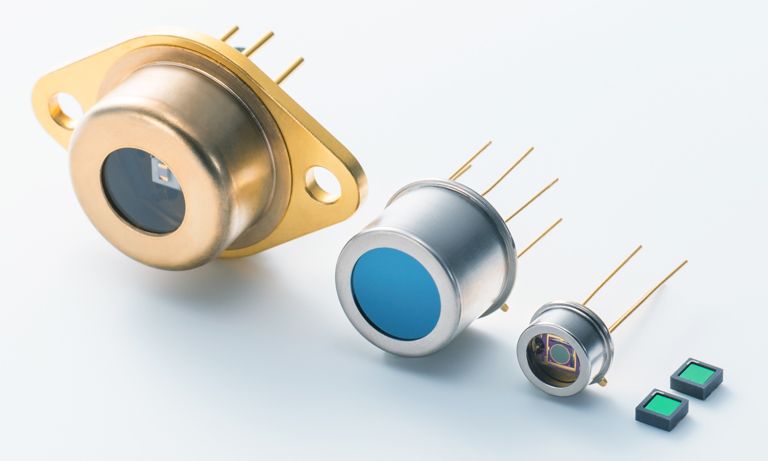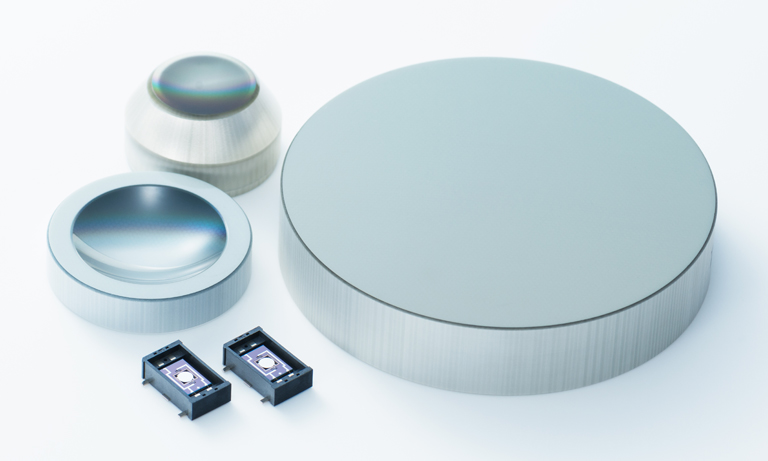Application notes
Technical notes
Ask an engineer
Publications
United States (EN)
Select your region or country.
A technical guide to silicon photomultipliers (MPPC) - Section 3
Ardavan Ghassemi, Hamamatsu Corporation
Kota Kobayashi & Kenichi Sato, Hamamatsu Photonics K.K.
January 11, 2018
3. Case studies of APD/MPPC performance calculations
In this section, we will conduct studies of APD/MPPC performance calculations for product selection. As part of this review, we will learn a number of key techniques to perform such calculations. As discussed in the previous section, please keep in mind that optical power [W], whose dimension is normalized to time, can be converted to units of photons (and vice versa) using equation 2-1.
Let’s suppose that an application demands the following conditions:
Peak wavelength of approx. 450 nm,
10 to 106 photons per pulse,
Pulse rates of 10 kHz to 1 MHz,
Typical pulses having widths of approx. 8 ns, rise times of approx. 3 ns, and decay (fall) times of approx. 5 ns.
And with the following requirements: absolute intensity of each pulse must be measured with nonlinearity below 10% while the optical design allows for a detector photosensitive area or field-of-view (FOV) of 3 mm per channel.
Note that the application conditions are fairly generic; many seemingly important details, such as what source is producing the light signal, do not affect these back-of-the-envelope calculations.
3-1. MPPC S/N
We focus on studying photodetector S/N at the signal’s low end. We use the typical specs of a regular Hamamatsu MPPC like the S13360-3050 (3 × 3 mm, 50 µm pixels):
- Total pixel count of 3600
- Typical PDE @ 450 nm = 40% at an overvoltage of 3 V
- Typical gain of 1.7 × 106 at an overvoltage of 3 V
- Typical dark count rate (DCR) = 500 kcps at an overvoltage of 3 V
- Terminal capacitance (Ct) = 320 pF
Using equation 2-2, we calculate charge output from a 10-photon input pulse: 10 × 0.4 × (1.7 × 106) × (1.6 × 10-19) = 1090 fC. The node sensitivity of a typical digitizing readout (like a QDC, which is the charge-digitizing equivalent of an oscilloscope with similar node sensitivity) is on the order of low 10s of fC/LSB (like 25 fC/LSB in the case of CAEN V965), and since 1090 fC > 25 fC, we conclude that S13360-3050 will be suitable for applications such as particle or nuclear physics in which use of flash digitizers (a QCD is simply a digitizer with on-board charge-to-voltage conversion) is prevalent; that is commonly the case if pulse shape information is required. However, such readout schemes are highly costly and power-intensive, making them unsuitable for common scientific, industrial, or consumer applications.
A cost-effective alternative readout scheme is use of photon-counting circuitry such as a multi-channel analyzer (MCA), consisting of discriminator/scaler, counter, and other signal processing functions. Towards using equation 2-8 to calculate S/N for this scheme, the desired counting integration time must be determined. For the sake of our discussion, let’s assume that is 1 ms for which S13360-3050’s DCR would yield 500 k × 1 m = 500 dark counts. Using equation 2-8, we set S/N = 1 and solve to obtain . At a min. pulse rate of 10 kHz, 10 photons per pulse would yield 100 photons in 1 ms. Alternatively, 100-photon S/N can be calculated using equation 2-8 to be .
We repeat the same for S13360-3025 (3 × 3 mm, 25 μm pixels) with PDE @ 450 nm = 25% and typical DCR = 400 kcps to obtain an incident light level of for S/N = 1 (by solving ) or alternatively calculating S/N for 100 photons as .
It is noteworthy that “excellent” S/N is generally considered to be ≥ 10. Most instrument designers typically have a target performance of S/N > X in mind for which X is greater than 1 (even if less than 10). Thus, it is important to use the value of X that represents the instrument designer’s target S/N in the above calculations. For example, if X = 5, the above calculations would yield Nphoton = 312 for S13360-3050 and Nphoton = 453 for S13360-3025. These results would mean that a portion of the lower range of the expected signal levels could not be detected with the target S/N (= 5) performance in this case.
3-2. MPPC linearity
We now assess how linear a MPPC’s response would be under this application’s conditions:
- MPPC pulse-height linearity: The question we face here is: up to how many 450 nm photons would S13360-3050 or S13360-3025 be able to detect with 10% max. nonlinearity? To answer this, we first obtain the pixel capacitance4 by utilizing the nominal value of the MPPC’s typical gain, assuming a unit of electrons for it and converting it to charge in coulombs, and then dividing the resulting charge by the specified overvoltage corresponding to that gain value. We thus have: . Using the quenching resistor value5 of a 50 μm MPPC pixel, we then calculate S13360-3050’s pixel recovery time to be 63 ns [approx. 4.6 × 91f × 150k where 4.6 = –ln(0.01) corresponds to a 99% MPPC recovery] and compare to the application’s light pulse width. Since the condition PW < Trecovery is met (8 ns < 63 ns), we use equation 2-13 to plot the MPPC’s expected response and compare that to its ideal response as obtained from equation 2-12 in Microsoft® Excel® and look for the point at which the 2 plots diverge by 10%. We perform the comparison by plotting the resulting nonlinearity using the combination of equation 2-10 and equation 2-11.
4 Another approach could also be used to determine pixel capacitance; it consists of dividing the specified MPPC terminal capacitance by pixel count, which yields 88 fF (= 320 pF / 3600 pixels) in the case of S13360-3050. Please note, however, that measurement of MPPC gain is affected by the quenching resistor’s parasitic capacitance while measurement of terminal capacitance is affected by the parasitic capacitances of the quenching resistor and also MPPC package and traces, and thus, either method overestimates the MPPC pixel’s junction capacitance (considering that both parasitic capacitances are in parallel to the junction capacitance). This overestimation becomes particularly significant for MPPCs with smaller pixel sizes (10 μm and 15 μm in Hamamatsu’s lineup) whose junction capacitances are relatively quite small.
5 MPPC Rq values: 1 MΩ for 10 μm pixels, 1 MΩ for 15 μm pixels, 300 kΩ for 25 μm pixels, 150 kΩ for 50 μm pixels
![]()
Figure 3-1 Linearity calculation with Microsoft® Excel®
For S13360-3050, the point of 10% nonlinearity is at about 2000 photons:
![]()
Figure 3-2 Count of fired pixels vs. photons
![]()
Figure 3-3 Nonlinearity vs. photons
For S13360-3025, by repeating the same calculations and plots, we find the point of 10% nonlinearity to be about 12000 photons:
![]()
Figure 3-4 Count of fired pixels vs. photons
![]()
Figure 3-5 Nonlinearity vs. photons
- MPPC pulse-rate linearity: From the application conditions, we see that the shortest inter-pulse time is longer than S13360-3050’s pixel recovery time (92 ns > 63 ns), so this application is within the pulse-rate linearity range of the S13360-3050.
3-3. APD S/N
Now, let’s assess APD’s S/N at those signal levels above which MPPC linearity falls short of the application’s linearity requirement. We choose a blue-enhanced APD of suitable size, like Hamamatsu’s S8664-30K, and utilize its characteristics () in equation 2-7 to calculate S/N. Considering that the application is photometric (i.e. measuring the amount of incident light in absolute terms for which a charge amplifier is required), we also use the readout noise spec of a sufficiently fast charge amplifier (one that can resolve a single pulse at the max. pulse rate); we note 993 e- in case of Analog Devices AD8488. Note that the charge amplifier’s bandwidth (as inverse of its integration time) must be at least twice that of the application’s max. expected pulse rate, and hence, we will use 2 MHz as the min. amplifier bandwidth limit. We proceed to calculate . Using equation 2-7, we thus have for 2000 photons and for 12000 photons.
As mentioned before, excellent S/N is typically considered to be ≥ 10. Therefore, in such a photometric application using a charge amplifier, we conclude that S8664-30K can perform well at those signal levels at which S13360-3050 and S13360-3025 exhibit excessive nonlinearity. Thus, it is imperative to use S13360-3050 (instead of S13360-3025) in photon-counting mode to detect the smaller pulses in this application but then consider using S8664-30K for pulses > 2000 ph.
As a side exercise, we calculate the APD’s S/N for making a relative measurement (requiring a resistive trans-impedance amplifier for readout) under the same conditions. First, let’s explore the case that the APD and its output amplifier circuit are intended for use as a pulse counter, which would make the signal’s highest-frequency component to be the max. expected pulse rate of 1 MHz. Since the output amplifier’s bandwidth must be at least twice that of the measurement frequency (which would be the frequency of the signal’s highest-frequency component that is to be detected), we adopt 2 MHz as our min. amplifier bandwidth limit (or cutoff frequency in other words). Using equation 2-6 along with S8664-30K’s characteristics [ [derived from QE by equation 2-5], ] and Texas Instruments amplifier OPA380 characteristics (readout noise spec of resulting in an estimated readout noise of approx. 14 pA at 2 MHz), we have:
for detecting pulses of 2000 photons or 0.88 fJ of incident 450 nm light per pulse at a rate of 1 MHz, and
for detecting pulses of 12000 photons or 5.28 fJ of incident 450 nm light per pulse at a rate of 1 MHz.
Now, let’s study the case that the APD and its output amplifier circuit will be used to perform pulse-shape discrimination (PSD) on signal pulses, which would require the signal’s highest-frequency component to be obtained from its rise time (since shorter than the fall time) by the following approximation . Like before, since the output amplifier’s cutoff frequency must be at least twice that of the measurement frequency, we adopt 234 MHz as our min. amplifier bandwidth limit. Using equation 2-6 along with S8664-30K’s characteristics and Analog Devices amplifier AD8015 specifications (indicating a readout noise spec of resulting in an estimated readout noise of approx. 46 nA at 234 MHz), we have:
for 2000 photons or 0.88 fJ of incident 450 nm light per pulse with a pulse width of 8 ns, and
for 12000 photons or 5.28 fJ of incident 450 nm light per pulse with a pulse width of 8 ns.
These results show that the above signal amplitudes are too low for relative detection at such high bandwidths using S8664-30K and the aforementioned amplifiers. So, let’s calculate at what signal levels we could attain S/N = 1 and S/N = 10 using S8664-30K and the above amplifiers at the same bandwidths.
For the earlier scenario of detecting and counting 450 nm light pulses at a rate of 1 MHz using S8664-30K, we have:
which yields Sinput ≈ 127 pW or ≈ 288 450 nm photons per pulse at 1MHz of pulse rate.
which yields Sinput ≈ 1.51 nW or ≈ 3412 450 nm photons per pulse at 1MHz of pulse rate.
For the latter scenario of performing PSD on 450 nm light pulses with a rise time of 3 ns (and thus, amplifier bandwidth of 234 MHz) using S8664-30K, we have:
which yields Sinput ≈ 3.6 nW or ≈ 66 450 nm photons per pulse with a width of 8ns.
which yields Sinput ≈ 71 nW or ≈ 1283 450 nm photons per pulse with a width of 8ns.
3-4. APD linearity
We now discuss how linear S8664-30K’s response would be under this application’s conditions:
- Pulse-rate linearity: For this, a calculation of response cutoff frequency using equation 2-15 would be made based on the terminal capacitance values specified in Hamamatsu’s APD datasheets for a load resistance of 50 Ω. However, APD cutoff frequency values (calculated in the same way) are provided in Hamamatsu’s APD datasheets (so no need to calculate!). In the case of S8664-30K, the specified cutoff frequency is 140 MHz, which far exceeds this application’s max. pulse rate of 1 MHz.
- Pulse-height linearity: For calculating the upper limit of pulse-height linearity, one would calculate the APD’s charge storage capacity by using Q = Ct x Vbias in which Vbias is the APD’s reverse bias voltage for the desired gain; please note that plots of APD gain and terminal capacitance vs. reverse voltage are provided in Hamamatsu APD datasheets. For our case study, we will use S8664-30K’s terminal capacitance of 22 pF and the reverse bias voltage of 360 V for the optimal gain of Mopt = 50 to obtain a charge storage capacity of 7.9 nC. Back-calculating from that charge storage capacity by taking S8664-30K’s QE (0.75 @ 450 nm) and optimal gain (Mopt = 50) into account, we arrive at a photon count of 1.3 × 109, which is larger than the max. photon count of 106 per pulse in this application. Thus, this application is within S8664-30K’s pulse-height linearity.
Furthermore, one also needs to take the readout circuitry into account. For example, Hamamatsu’s H4083 charge amplifier has a 2 pF storage capacitor biased up to the rail voltage of 12 V, which by Q = C × V yields a max. charge storage capacity of 24 pC or 1.5 × 108 electrons (or alternatively obtained by max. output voltage of 12 V divided by gain of 0.5 V/pC). Like the previous step, back-calculating from that amount of charge by taking S8664-30K’s QE (0.75 @ 450 nm) and optimal gain (Mopt = 50) into account, we arrive at a photon count of 4 × 106, which is larger than the max. photon count of 106 per pulse in this application. Thus, pulse-height linearity would not be limited by the charge amplifier circuitry if H4083 is utilized in this case.
3-5. Conclusion
In conclusion, please note that multiple products could turn out to be suitable for a given set of application conditions. By taking price information into consideration, those options can be trimmed down to one or more candidates for characterization and evaluation. With that, considering their peculiar complexities, we will dedicate the next section to describing methods of measuring MPPC characteristics and discussing their specifics.
- Confirmation
-
It looks like you're in the . If this is not your location, please select the correct region or country below.
You're headed to Hamamatsu Photonics website for US (English). If you want to view an other country's site, the optimized information will be provided by selecting options below.
In order to use this website comfortably, we use cookies. For cookie details please see our cookie policy.
- Cookie Policy
-
This website or its third-party tools use cookies, which are necessary to its functioning and required to achieve the purposes illustrated in this cookie policy. By closing the cookie warning banner, scrolling the page, clicking a link or continuing to browse otherwise, you agree to the use of cookies.
Hamamatsu uses cookies in order to enhance your experience on our website and ensure that our website functions.
You can visit this page at any time to learn more about cookies, get the most up to date information on how we use cookies and manage your cookie settings. We will not use cookies for any purpose other than the ones stated, but please note that we reserve the right to update our cookies.
1. What are cookies?
For modern websites to work according to visitor’s expectations, they need to collect certain basic information about visitors. To do this, a site will create small text files which are placed on visitor’s devices (computer or mobile) - these files are known as cookies when you access a website. Cookies are used in order to make websites function and work efficiently. Cookies are uniquely assigned to each visitor and can only be read by a web server in the domain that issued the cookie to the visitor. Cookies cannot be used to run programs or deliver viruses to a visitor’s device.
Cookies do various jobs which make the visitor’s experience of the internet much smoother and more interactive. For instance, cookies are used to remember the visitor’s preferences on sites they visit often, to remember language preference and to help navigate between pages more efficiently. Much, though not all, of the data collected is anonymous, though some of it is designed to detect browsing patterns and approximate geographical location to improve the visitor experience.
Certain type of cookies may require the data subject’s consent before storing them on the computer.
2. What are the different types of cookies?
This website uses two types of cookies:
- First party cookies. For our website, the first party cookies are controlled and maintained by Hamamatsu. No other parties have access to these cookies.
- Third party cookies. These cookies are implemented by organizations outside Hamamatsu. We do not have access to the data in these cookies, but we use these cookies to improve the overall website experience.
3. How do we use cookies?
This website uses cookies for following purposes:
- Certain cookies are necessary for our website to function. These are strictly necessary cookies and are required to enable website access, support navigation or provide relevant content. These cookies direct you to the correct region or country, and support security and ecommerce. Strictly necessary cookies also enforce your privacy preferences. Without these strictly necessary cookies, much of our website will not function.
- Analytics cookies are used to track website usage. This data enables us to improve our website usability, performance and website administration. In our analytics cookies, we do not store any personal identifying information.
- Functionality cookies. These are used to recognize you when you return to our website. This enables us to personalize our content for you, greet you by name and remember your preferences (for example, your choice of language or region).
- These cookies record your visit to our website, the pages you have visited and the links you have followed. We will use this information to make our website and the advertising displayed on it more relevant to your interests. We may also share this information with third parties for this purpose.
Cookies help us help you. Through the use of cookies, we learn what is important to our visitors and we develop and enhance website content and functionality to support your experience. Much of our website can be accessed if cookies are disabled, however certain website functions may not work. And, we believe your current and future visits will be enhanced if cookies are enabled.
4. Which cookies do we use?
There are two ways to manage cookie preferences.
- You can set your cookie preferences on your device or in your browser.
- You can set your cookie preferences at the website level.
If you don’t want to receive cookies, you can modify your browser so that it notifies you when cookies are sent to it or you can refuse cookies altogether. You can also delete cookies that have already been set.
If you wish to restrict or block web browser cookies which are set on your device then you can do this through your browser settings; the Help function within your browser should tell you how. Alternatively, you may wish to visit www.aboutcookies.org, which contains comprehensive information on how to do this on a wide variety of desktop browsers.
5. What are Internet tags and how do we use them with cookies?
Occasionally, we may use internet tags (also known as action tags, single-pixel GIFs, clear GIFs, invisible GIFs and 1-by-1 GIFs) at this site and may deploy these tags/cookies through a third-party advertising partner or a web analytical service partner which may be located and store the respective information (including your IP-address) in a foreign country. These tags/cookies are placed on both online advertisements that bring users to this site and on different pages of this site. We use this technology to measure the visitors' responses to our sites and the effectiveness of our advertising campaigns (including how many times a page is opened and which information is consulted) as well as to evaluate your use of this website. The third-party partner or the web analytical service partner may be able to collect data about visitors to our and other sites because of these internet tags/cookies, may compose reports regarding the website’s activity for us and may provide further services which are related to the use of the website and the internet. They may provide such information to other parties if there is a legal requirement that they do so, or if they hire the other parties to process information on their behalf.
If you would like more information about web tags and cookies associated with on-line advertising or to opt-out of third-party collection of this information, please visit the Network Advertising Initiative website http://www.networkadvertising.org.
6. Analytics and Advertisement Cookies
We use third-party cookies (such as Google Analytics) to track visitors on our website, to get reports about how visitors use the website and to inform, optimize and serve ads based on someone's past visits to our website.
You may opt-out of Google Analytics cookies by the websites provided by Google:
https://tools.google.com/dlpage/gaoptout?hl=en
As provided in this Privacy Policy (Article 5), you can learn more about opt-out cookies by the website provided by Network Advertising Initiative:
http://www.networkadvertising.org
We inform you that in such case you will not be able to wholly use all functions of our website.
Close















